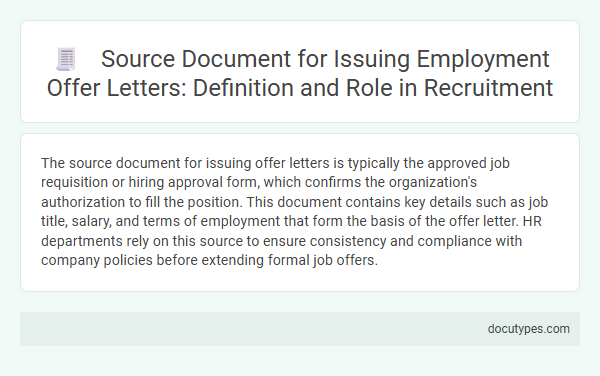The source document for issuing offer letters is typically the approved job requisition or hiring approval form, which confirms the organization's authorization to fill the position. This document contains key details such as job title, salary, and terms of employment that form the basis of the offer letter. HR departments rely on this source to ensure consistency and compliance with company policies before extending formal job offers.
Introduction to Source Documents in Employment
Source documents in employment serve as the foundational records that validate and authorize the issuance of offer letters. These documents ensure accuracy and legal compliance during the hiring process.
- Job Requisition Form - This document initiates the hiring process by detailing job requirements and approvals from management.
- Candidate Interview Evaluation - Provides assessments and feedback essential for making informed hiring decisions.
- Background Check Report - Confirms candidate credentials and eligibility, supporting the offer letter's legitimacy.
Employers rely on these source documents to create precise and legally sound offer letters for prospective employees.
Definition of Source Document for Offer Letters
The source document for issuing offer letters is the initial record or reference that contains the approved details of a job offer. It serves as the foundation for drafting a formal offer letter to a prospective employee.
This document typically includes key information such as the job title, salary, benefits, and terms of employment. Employers rely on this source to ensure accuracy and consistency in the offer letter content.
Importance of Source Documents in Recruitment
What is the source document for issuing offer letters? The source document for issuing offer letters is typically the job requisition or recruitment approval form. This document verifies the authorized position and details necessary for drafting an accurate and compliant offer letter.
Why are source documents important in recruitment? Source documents ensure transparency and accountability by providing official evidence of approved hiring decisions. They help maintain consistency, reduce errors, and support legal compliance throughout the recruitment process.
Types of Source Documents Used in Hiring
Source documents for issuing offer letters include resumes, job applications, and interview evaluation forms. These documents validate the candidate's qualifications and suitability for the position. Employers rely on these records to ensure accurate and compliant offer letter issuance.
Key Components of Employment Offer Letters
Employment offer letters are typically issued based on the source document known as the job offer approval or recruitment authorization. This document authorizes the terms and conditions that must be included in the offer letter.
- Job Title and Role - Specifies the position you're being offered and outlines key job responsibilities.
- Compensation Details - Includes salary, bonuses, and any additional financial benefits associated with the role.
- Employment Terms - Covers start date, work hours, probation period, and other contractual obligations.
Role of Source Documents in Verifying Candidate Information
Source documents are critical in the process of issuing offer letters as they provide verified information about the candidate. These documents include resumes, identification proofs, educational certificates, and prior employment records.
The role of source documents is to authenticate the candidate's credentials and ensure accuracy in the offer letter details. Employers rely on these documents to verify educational qualifications and work experience, reducing the risk of hiring discrepancies. Proper verification strengthens the credibility of the recruitment process and supports compliance with company policies and legal requirements.
Legal Implications of Source Documents in Recruitment
| Aspect | Description |
|---|---|
| Definition of Source Document | The source document for issuing offer letters is the original record or evidence that validates the recruitment decision. It includes job requisitions, candidate applications, interview evaluations, and internal approval forms. |
| Role in Recruitment | Source documents establish the authenticity of offer letters by providing documented proof of the hiring process, candidate selection, and compliance with organizational policies. |
| Legal Implications | Source documents serve as critical evidence in legal disputes or audits concerning employment offers. They ensure that recruitment practices adhere to labor laws, anti-discrimination statutes, and contractual obligations. |
| Compliance Requirements | Maintaining accurate source documents supports regulatory compliance, including equal employment opportunity (EEO) laws and workforce documentation standards mandated by government agencies. |
| Risk Mitigation | Proper management of source documents reduces risks of wrongful termination claims, breach of contract allegations, and enforcement actions related to unfair hiring practices. |
| Best Practices | Organizations should implement standardized procedures for collecting, verifying, and securing source documents to strengthen the credibility and legality of offer letters. |
Best Practices for Managing Source Documents
The source document for issuing offer letters is typically the candidate's job application and interview evaluation forms. These documents provide verified information about the candidate's qualifications, salary details, and job role which ensures accuracy in the offer letter. Best practices for managing source documents include secure storage, maintaining version control, and ensuring compliance with data privacy regulations.
Common Challenges with Employment Offer Documents
The source document for issuing offer letters is typically the approved job requisition or employment contract template. These documents ensure all relevant details are included accurately before the offer is extended.
Common challenges with employment offer documents include consistency, clarity, and legal compliance.
- Inconsistent Information - Discrepancies between the job description and offer letter can cause confusion and delay hiring.
- Lack of Clear Terms - Ambiguous language around salary, benefits, or start date may lead to misunderstandings.
- Non-Compliance Risks - Failure to include legally required clauses increases the risk of disputes and legal issues.
What Is the Source Document for Issuing Offer Letters? Infographic

